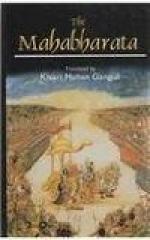37. ‘Brahmi night’ implies a night in course of which sacred hymns are sung.
38. Nakharaprasa-yodhina, Nilakantha explains, are those combatants who are armed with tiger-like claws made of iron and tied to their waists.
39. Suradevata is like karivringhati or govalivardda.
40. Ulupi is implied.
41. Implying the unfair character of the fight, for one on the earth should never be assailed by one on his car.
42. Yudhishthira was Dharma’s self, Vidura also was Dharma born as a Sudra through the curse of the Rishi Animandavya. Both, therefore, were of the same essence. When Vidura left his human body, he entered the body of Yudhishthira and thus the latter felt himself strengthened greatly by the accession.
43. Nilakantha here implies the peacock and not the blue jay, for the word keka is applied to the notes of the peacock alone. Datyuhas are gallinules or a species of Chatakas whose cry resembles, Phatik jal—phatik jal—phatik jal! repeated very distinctly, the second syllable being lengthened greatly.
44. Audumvaran is an adjective of kalasan. It means ‘made of copper’. Praveni is a kutha or blanket. Sruk is a ladle having the cup like cavity at one extremity only. Sruv is a ladle having cup-like cavities at both extremities.
45. Whenever a Brahmana cursed another, his penances underwent a diminution. Forgiveness was the highest virtue of the Brahmana. His power lay in forgiveness. Hence, when Mandavya cursed Dharma, he had to spend a portion of his hard-earned penances. Previously, the plea of minority or non-age could not be urged in the court of Dharma. Mandavya forced Dharma to admit that plea in the matter of punishment for offences.
46. Both Dharana and Dhyana are processes or, rather, stages of Yoga. The former implies the fixing of the mind on one thing; the latter is the abstraction of the mind from surrounding objects.
47. Valhika was the sire of Somadatta and the grandsire of Bhurisravas. Valhika, therefore, was the grand-father-in-law of the lady mentioned by Gandhari.
48. The puissance here referred to is that of Anima, Laghima, etc. i.e., the capacity of becoming minute and subtile, etc.
49. The sense is that those had been incarnated as human beings and fighting with one another met with death as regards their human existence.
50. Nilakantha explains that anayasakritani karma implies the religion of Nivritti, for the religion of Pravritti consists of acts that require ayasa or exertion for their accomplishment. The religion of Nivritti or abstention from acts is said hereto be true and superior, and productive of real fruit, in the form, that is, of Emancipation. The soul, however, in the generality of cases, united with ebhih, by which is meant ayasa-kritam karma, that is, the acts done in pursuance of the religion of Pravritti, becomes embodied and, therefore, enjoys happiness or endures misery as the case may be.




